Apr 16, 2014 | guest post
The common form of advertising is a form of communication used to persuade viewers or listeners to purchase a new product. But did you know that an outstanding radio or TV ad can also be referred to as a form of art?
When people hear the word “art,” they usually relate it to paintings and sculptures, like Da Vinci’s “Mona Lisa,” or Michelangelo’s “David.” Art is used to chronicle events, tell a story, create statements or convey emotions. Art, when used effectively in radio and television advertisements, can influence a person’s feelings, attitudes and ideals, and even persuade the audience to purchase a product or service. A Super Bowl Pepsi commercial may not have a place in the Louvre but the ad fits this definition of art.
Audio Art
Despite the fact that it only appeals to our sense of hearing, an excellent radio ad utilizes various art forms such as music, script writing, sound effects and vocal talent to create visual images in the listener’s mind and to bring the ad to life. After the writer finishes the script, sound engineers would then manipulate the sounds to capture the perfect pitch, tone and volume. One of the best radio ads of 2012 is Earphone Bully. It even won a Gold Radio Lion at Cannes the same year.
Visual Art
With all the advanced technology available on the market, graphic artists are able to create remarkable visual effects through computer-generated graphics and animation. The famous 2006 Coke commercial from the Netherlands was shown worldwide because of its brilliant use of animation.
Cinematography & Photography
A simple concept may result to an explosive TV advert with the amazing use of cinematography. Just like Budweiser’s “Puppy Love” commercial from the recent Super Bowl season. It is a simple concept but the sequences and how the entire commercial was shot plus the music accompaniment appeals to the masses.
Even online gaming companies know the importance of a great cinematography. Online bingo game Iceland Bingo may have used two simple ducks walking down the road, but how the commercial was executed really gets the point across: Play bingo and you will have fun.
Same thing goes with photography. A plain food and beverage can turn into a visual masterpiece with just the right lighting and positioning of the camera to capture the perfect angle. All these artistry can contribute to sell a product successfully.
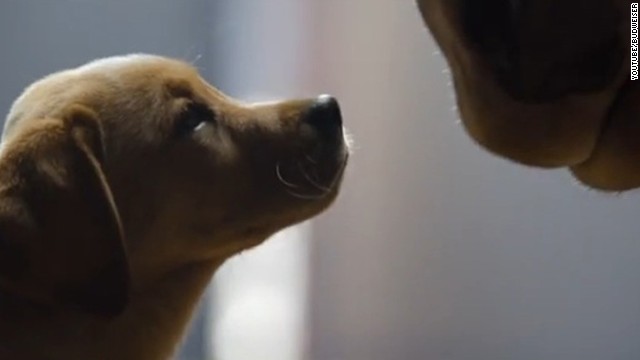
Disclaimer: This is a guest post!
Apr 6, 2014 | collage, interviews, painting
Pascal Janssen‘s talent for creating faces makes it hard to believe he’s just 21 years old. The Belgian artist paints, draws and collages features with so much emotion in them, each face nearly breathes with life.
He mostly draws portraits of his friends, occasionally including a favorite musician. He captures those moments of revelation and self-doubt as each new set of eyebrows and chins depict them, emphasizing each subtlety to reveal a depiction truer than a photograph.
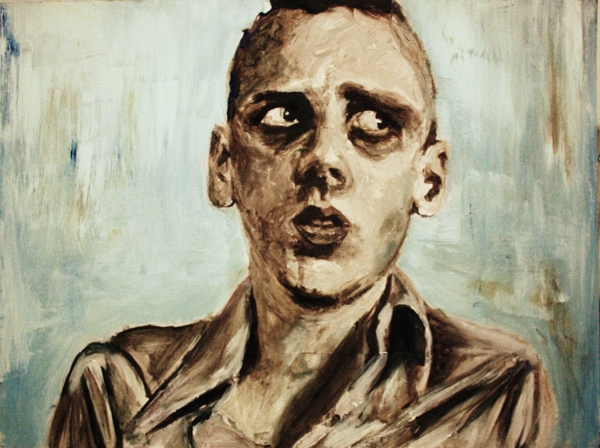
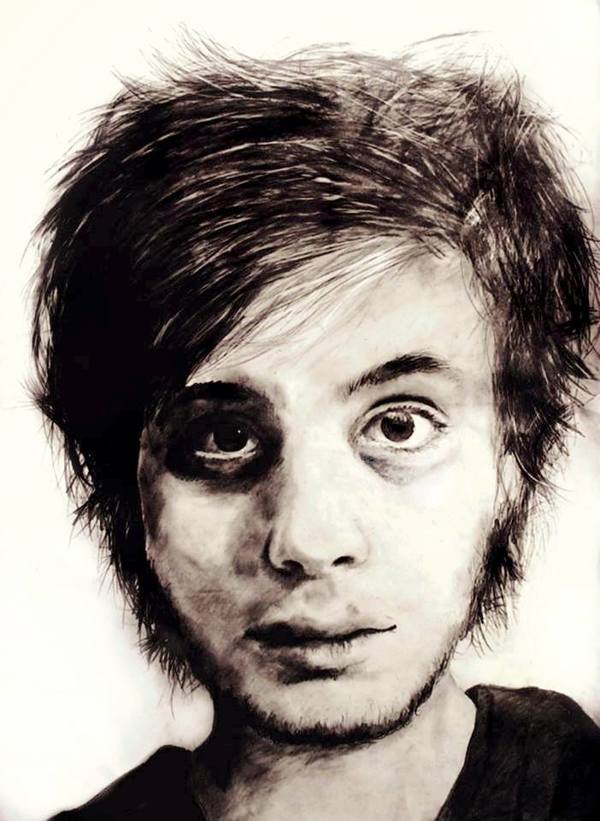
“My artwork is mostly based on the mind of the human being, how it’s perception on the world and itself is,” he writes.
Drugs and their affects also played a role in the formation of his work. Pascal seems fascinated by the changes drugs cause within the body, and how those changes manifest themselves in expressions.
Pascal was nice enough to answer my questions about his work, and how his fixation on the face began:
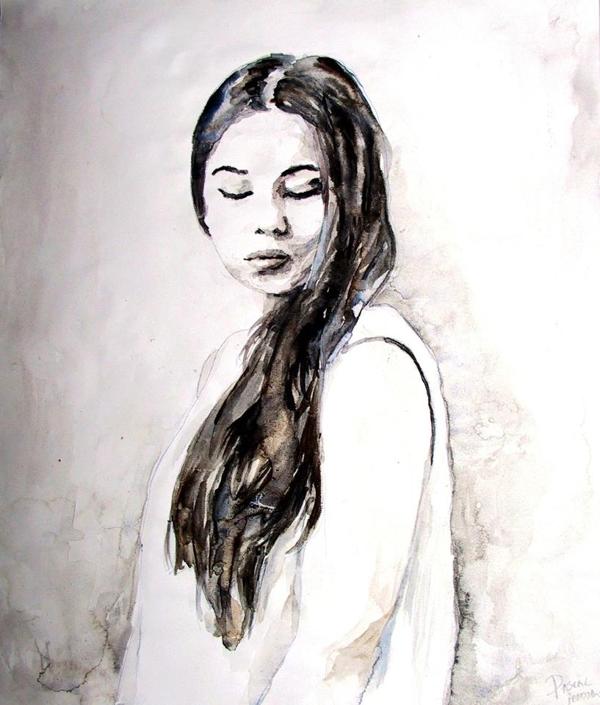
How has living in Belgium helped shape your art? What do you like most about Hasselt?
Even though art in Europe is more active in Berlin, Belgium is also a nice place for an artist. You have a lot of art schools around the country. My parents sent me to art classes since I was in kindergarden, it was once a week and just for fun.
I quit those art classes when I went to high school in Hasselt where I did visual arts. I really loved it there and had a great time, the people there were a lot more open minded than they were in middle school. I really hated middle school, some teachers even mocked me for planning to go to art school.
But I couldn’t care less, I always wanted to be an artist. And for now I’m studying at an art college, just next to my high school. I’ve always loved Hasselt. It’s not the most interesting place in Belgium like Gent, Antwerp or Brussels. But I do feel safe there, it feels like home. I currently live at Rekem, close to the border of the Netherlands where Maastricht is located. Maastricht is also a nice place for an artist, I had my first exhibition there with 7 other artists in September 2013 and planning to have my first solo exhibition there in April 2014.
When did you first start creating portraits? Can you remember the first person you ever painted?
I don’t really remember, I probably had some assignments to paint or drew a portrait for school, but didn’t care about it cause I mostly just made what I felt like making. When I was in elementary school I drew a lot of cartoons but when I went to high school I mostly painted abstract paintings and when I was around 17 I really noticed I just love painting portraits.
And that was when I created “Ignorance is Bliss.” It’s a portrait of some stoner, to this day I still don’t know who this guy is but I thought it was kinda hilarious to paint him because my teachers back then hated anything that had something to do with drugs. Most of my work back then had references to drugs and sometimes it still does, because I still think it has some interesting factors like hallucinations, psychoses, addiction, depersonalisation, etc. I think making portraits is something I’ll always will love doing, but I’m always open to paint new things or use new techniques. I like to experiment a lot.
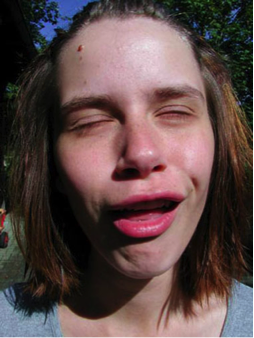
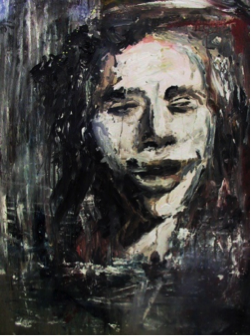
What do you love about reinterpreting the human face over and over again?
I never thought about that really, for me it’s more than just a face. It’s like I’m painting a complete person as he or she is, or just how I feel about them. I like painting my favorite musicians. Mostly musicians who make lyrics which reflect the thoughts and feelings in my life, like King Krule, I love the melancholy in his music. But I mostly love to paint my friends, like I said it’s more then just a face.
How long does it usually take to create each of your works, and what methods do you use to create them?
I mostly work in a fast tempo, it takes normally about an hour or 2, depending on size of course. And if I start working on a piece, I don’t stop untill it’s finished or else I just start all over again. I learned to paint this fast because I work a lot with watercolor. With that kind of paint you have to work fast and you cannot really correct mistakes.
My technique with watercolor also had an effect on my technique with painting in oil. I use a lot of terpentine on my oil paintings just like I use a lot of water on my watercolor paintings. I also don’t use white oil paint, instead I use gesso, a thick paint you actually use for preparation of your canvas. I never really liked working traditionally I guess.
What’s one of your favorite quotes about art and how do you see it applying to your own work?
The quotes of Vincent van Gogh are my favorites, they might sound cheesy but I love them: ” If you hear a voice within you say ‘you cannot paint,’ then by all means paint, and that voice will be silenced.” Criticism has always motivated me even if it came from within me. I’m not trying to be a better artist then somebody else, I’m just try to be better than myself.
“I feel that there is nothing more artistic than to love.” As the romantic person I am, love has always motivated me to paint.
“I know nothing with any certainty, but the sight of stars make me dream.” I’m also a very agnostic person who will question about anything, but I do have an endless fascination for the universe.
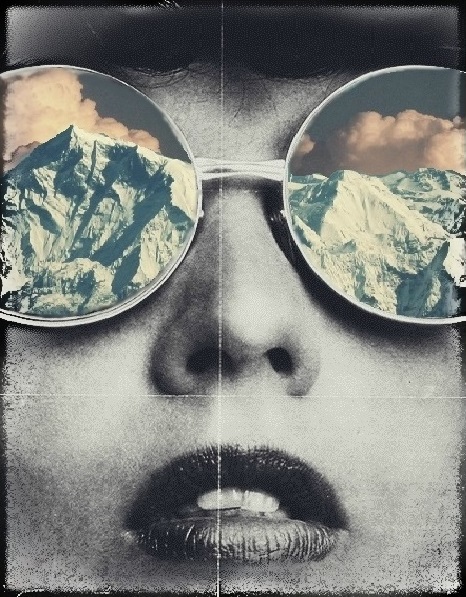
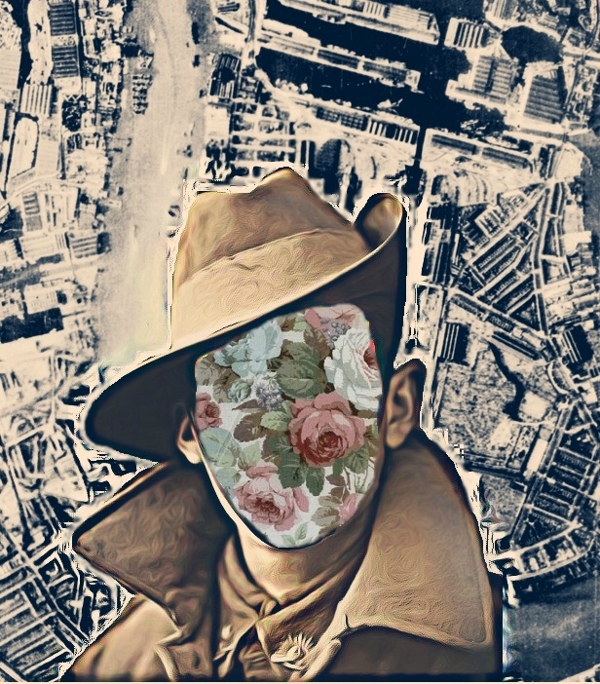
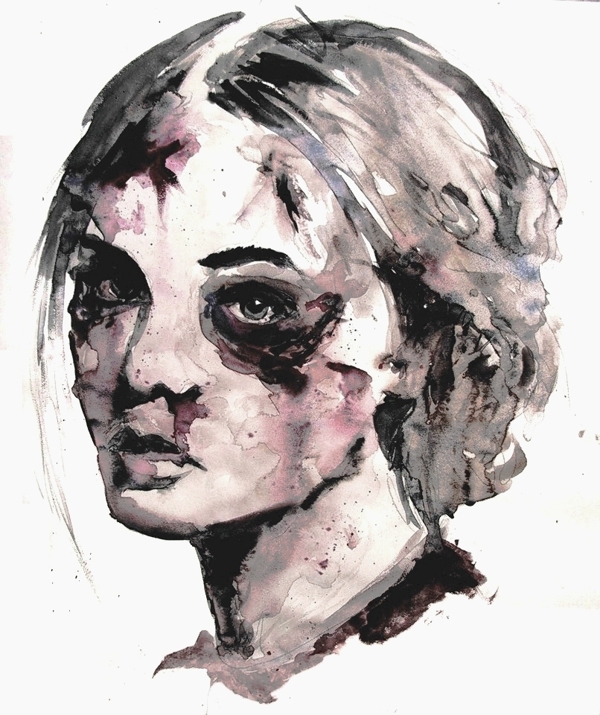
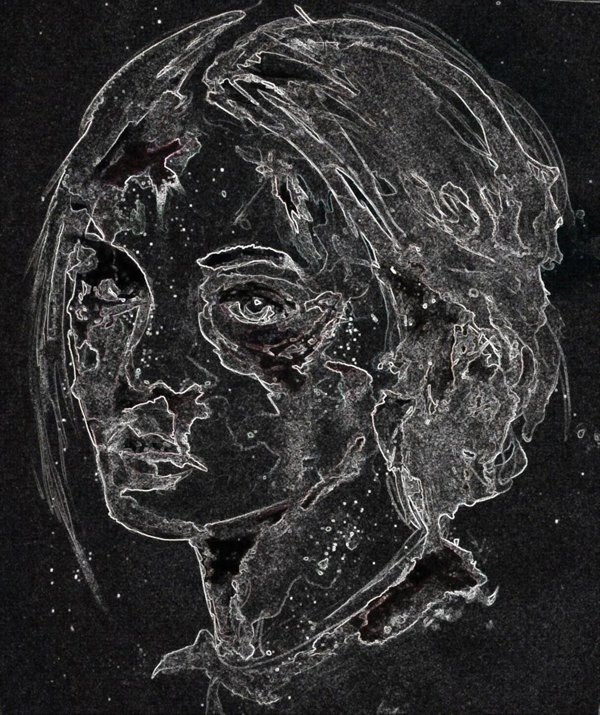
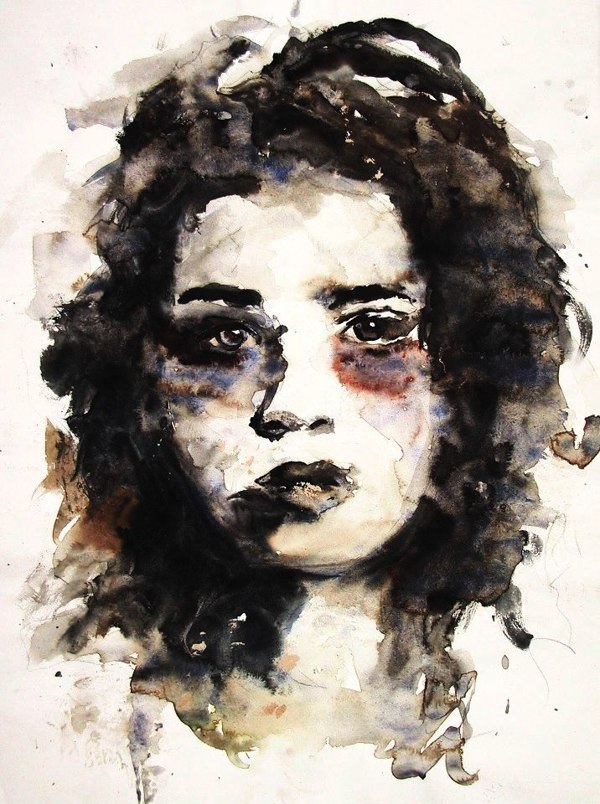
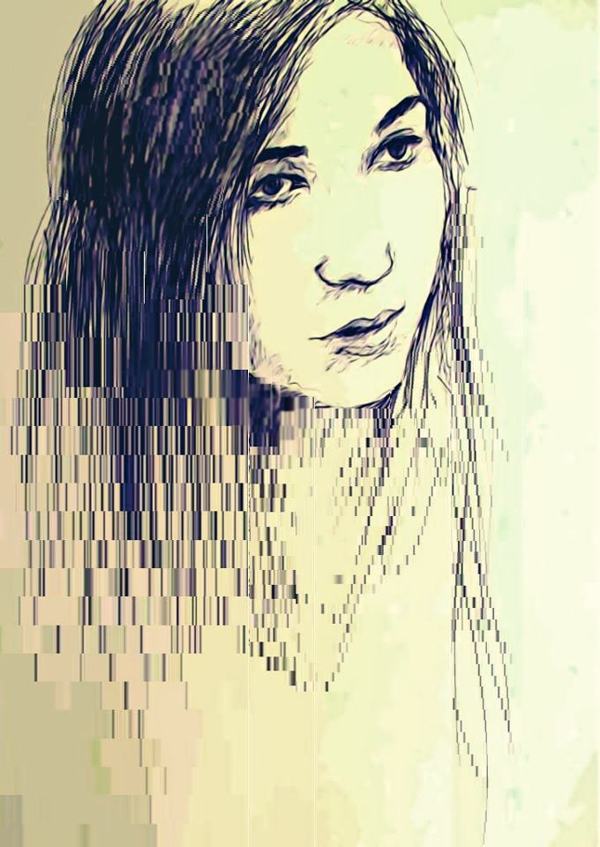
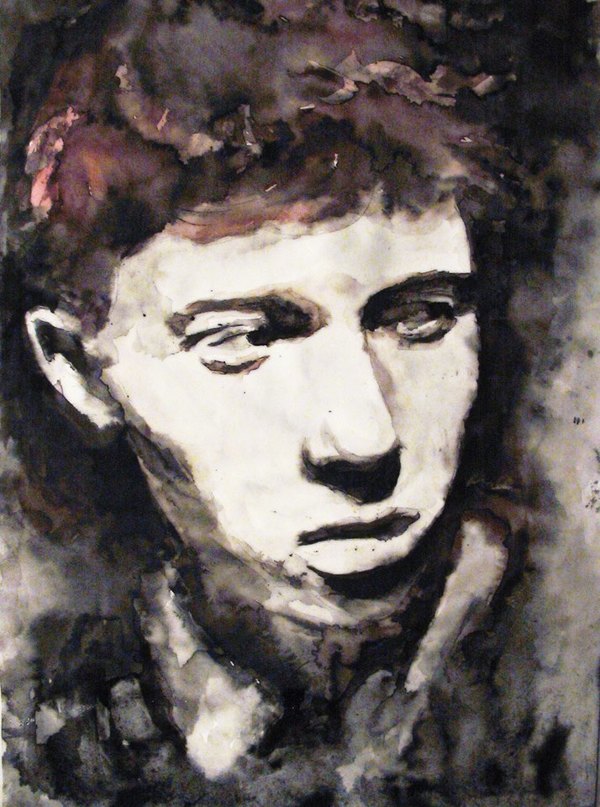
For more from Pascal, you can find him on Facebook, Tumblr and Behance.
Jan 28, 2014 | art history, interviews, sculpture
An artist from Athens, Greece, Teodosio Sectio Aurea paints with shadows, using sculpture and light to recreate masterpieces in negative space. He takes us through a tour of art history using different types of sculpture to match each shadow — thick black metal for “Guernica,” a cherry blossom tree forms a woman in “Akina – spring flower,” and DNA beads form the “Vitruvian Man.”
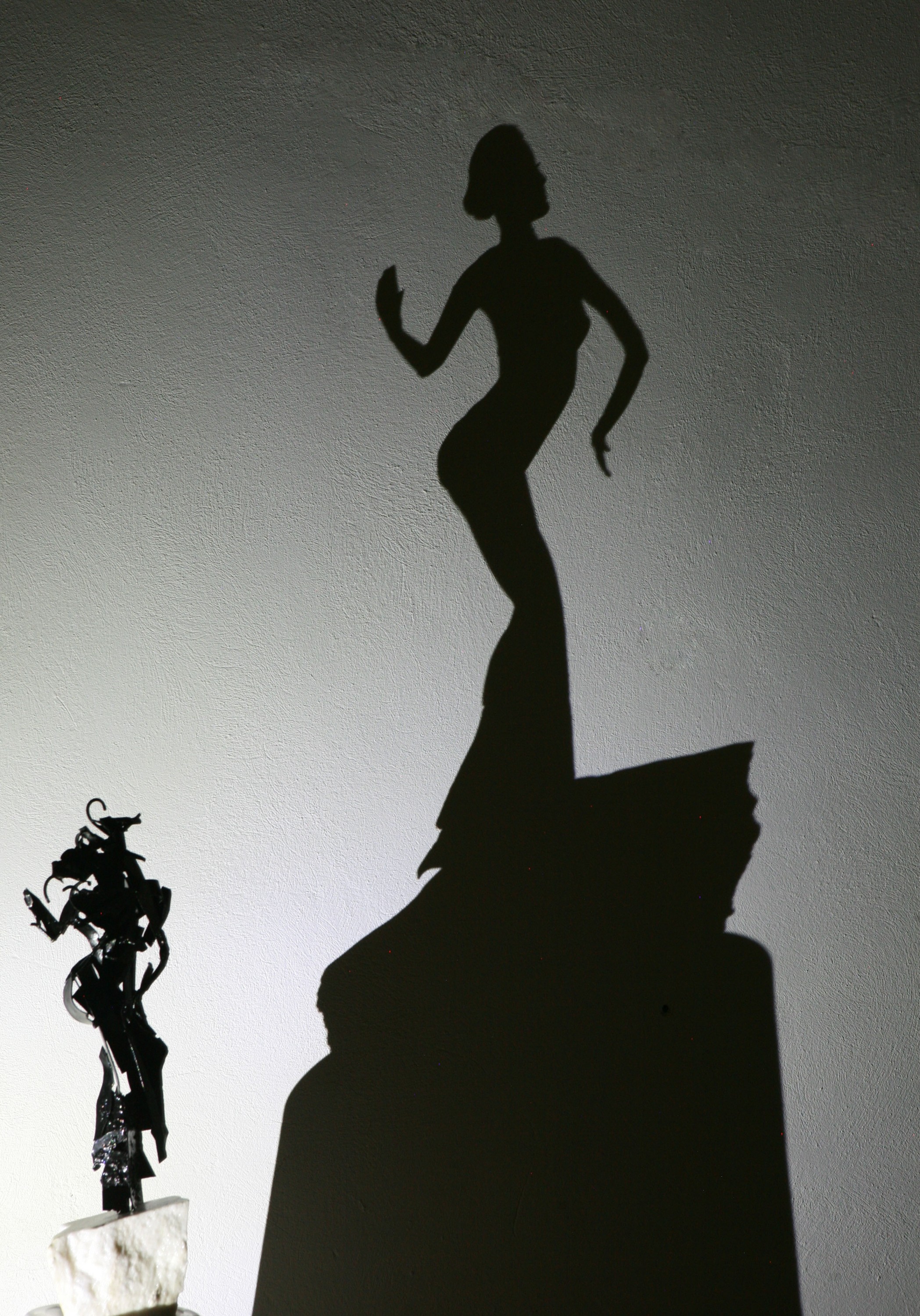
How does living in Athens affect your art?
I am not an Athenian or a Greek, but a citizen of the world. Socrates, from Plutarch said Greece is the most beautiful places on Earth.
When did you first start experimenting with shadow art?
I started my shadows one year ago, I just sort of ”woke up” you know?
How long does it typically take you to work with the negative space?
Some shadows are difficult, but nothing is impossible.
What’s one of your favorite quotes about art?
“In art we trust.”
Who’s are a few of your art idols?
Dali, Pollock, Kandinsky, Da Vinci, and again Dali :)))))




For more of Teodosio Sectio Aurea’s work, see his website and Facebook page.
Dec 12, 2013 | collage, interviews
Gabriel Folli is a young French artist, working in nearly every medium to interpret his memories and the world around him. He’s studied at the University of Amiens, near Paris since 2009 and has exhibited in Amiens, Abbeville and Bourges, France this year.
His collaged works are my favorite — layer upon layer of photographs and color that turn memories into dreams — or nightmares, depending on what frightens you. But his portfolio finds balance in representational paintings and drawings of landscapes. They hold shadowed horizons taken from photographs, and the sheets of skyline can be rearranged and randomized to create places that don’t exist.
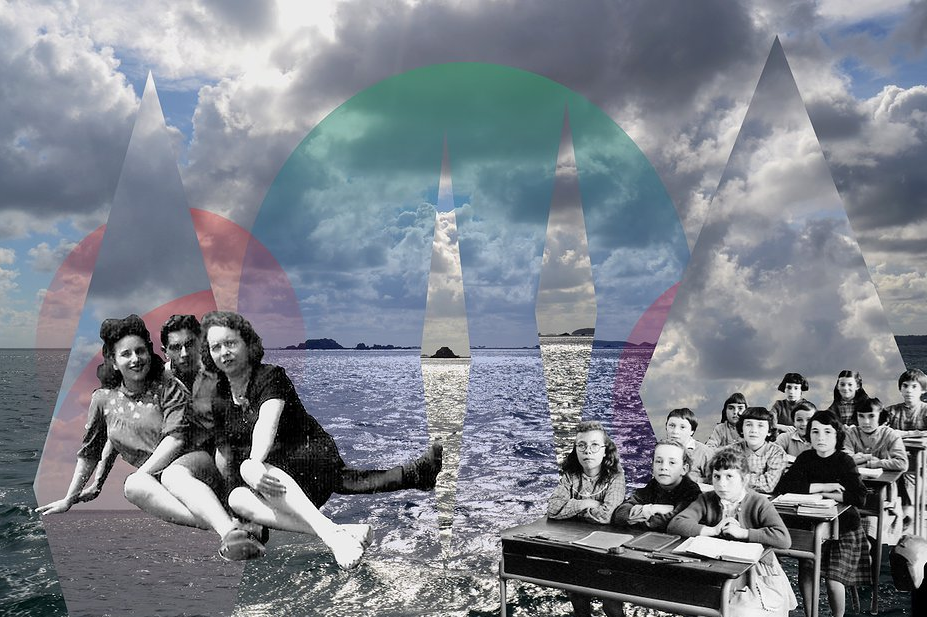
When did you first know you wanted to be an artist? What’s the first artwork you can remember ever creating?
I began to draw comic strips when I was 13 or 14 years old. I wanted to make it my job. During the high school I created many drawings and installations… Concerning the works I make today, the first work which had an influence on the others was a video called Open Door, created in 2012.
Where do you find the images for your collages? How do you piece them together?
Initially, I take photos of landscapes which make up the background of the collage. Then, the characters are members of my family, my friends…I find theses photos in my family’s archives, most of them are old photos that come from the house of my grandparents. I give them a second life.
For the construction of collages, I look for people who can correspond to the landscape, or not, and I play with the hot colors. In my work in general, there is a strong contrast between warm colors, light and the black of darkness. I want to create idealized and fantasized situations in my collages.
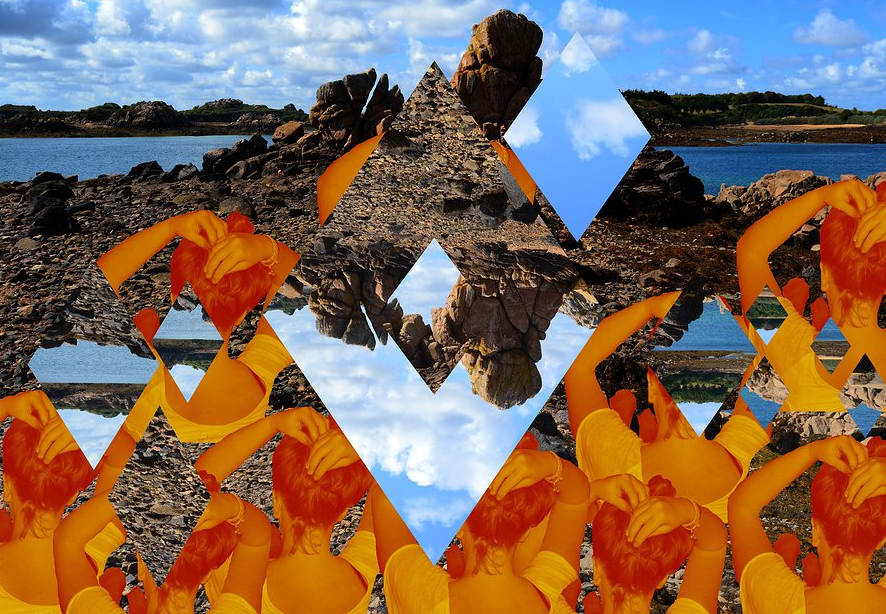
Do you create your drawings from photographs? What about landscapes inspire you to depict them in so many different ways?
Yeah, my drawings are created from photographs. Photography (or video) is often the basis of my work. I use photos to create drawings, paintings, collages…
The photography is not really the purpose but a way. Every drawing corresponds to a memory, and all of theses drawings create a life, my life, in which the memories are mixed and modified with time. Drawings are put on a same horizon line, in a random choice, and form a unique landscape.
Who are a few of your art idols, and do you think they played a role in the formation of your own work?
A lot of artists are influence my work, it’s certain! I discover most of these artists on the Internet or in books, among whom many are not very well-known. I like the work of Monika Traikov, Fabienne Rivory, Sergey Larenkov, Lorna Simpson or Alexander Schellow, one of my favorite artists. Each of them has a different approach, and in my work, I try to find new techniques to realize my memories, and at the same time, destroy them.
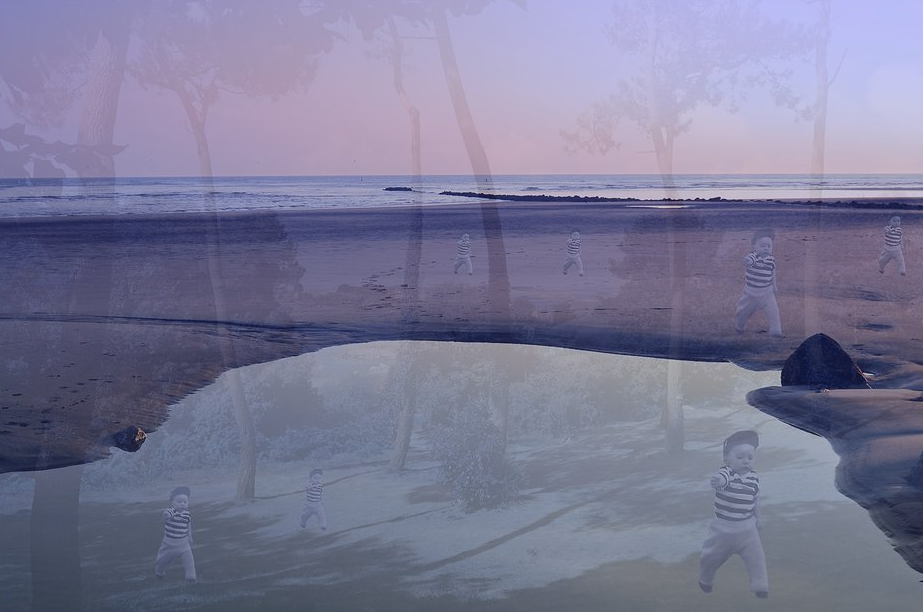
Which places most inspire you to create your landscape works?
I like the nature more than the city. A lot of my photographs are taken in the nature, in front of the sea or forest. I am interested by the night too. The night brings me a lot of contemplation, silence, solitude. Besides, I often create during the night.
What’s one of your favorite quotes about art?
« Je composerai jusqu’à la décomposition. » Serge Gainsbourg
In English : “I shall compose until the decomposition”
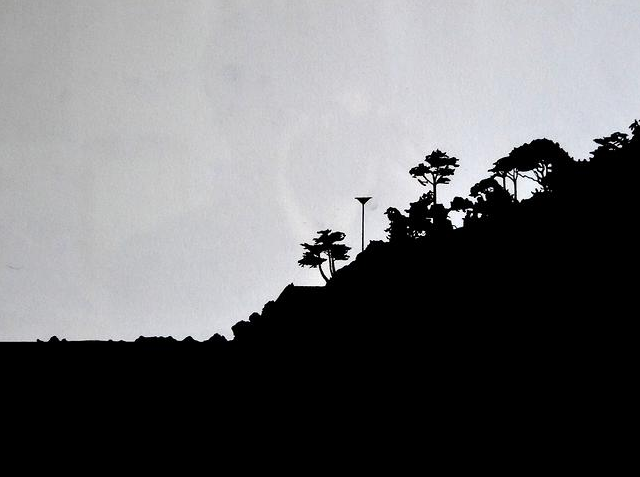

For more from Gabriel, check out his Twitter, Tumblr and website.
Oct 24, 2013 | interviews, painting
Ilaria Berenice is an Italian artist who uses color and loose forms to express herself on paper. Her works keep their wet, fluid feel even though the paint has long been dry. Every stroke looks intentional and spontaneous all at once, and the bright colors she uses brings every shape and form to life. She studied anthropology and ethnology at the University of Siena, but didn’t begin painting until traveling through Brazil, Italy and Spain in the early 2000s.
Now, her work has has been exhibited all over Italy and featured in multiple publications including the Spanish critic Eva Minguet Camara’s 2008 book “Ilustraciòn de vanguardia” (“Art illustration”). This past summer Ilaria had a solo exhibition at one of the biggest castles in Europe, at Castel Brando, between Venice and the Dolomites.
When you sit down to complete a portrait, do you already have an idea of how realistic you want to convey the sitter?
When I started to make committed portraits with oil, the goal was to make them as realistic as possible. But when I make them with mixed media, I just catch the glimpse of the soul and personality of the person, or just an aspect, while playing and having fun with the sign between shadows and lights, and strangely enough they look more familiar with the sitter than the realistic ones, to me.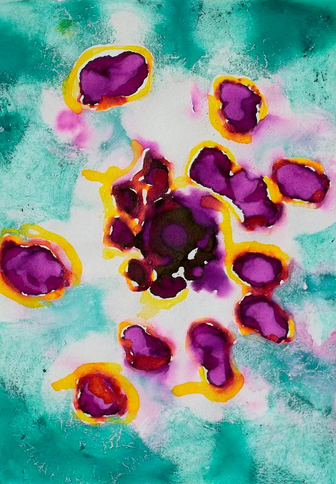
You write that your collection of “Visionary” work is inspired by momentary situations and ideas. Can you tell us the story behind your mixed media work “Venice”?
I love the work “Venice,” overall because is the latest one. Well I just played with stains of blue and green, made of pigments, glue and water, then I let the work on the easel appear whatever. The day after I saw Venice on it, I just allowed what I saw to come out.
What do you use for reference in your anatomy drawings?
I did them last winter at the Brera academy here in Milan where there is a real skeleton. While for the muscles I used pictures, and for the people I used real people, all in the class of the artist and professor Maria Tcholakova.
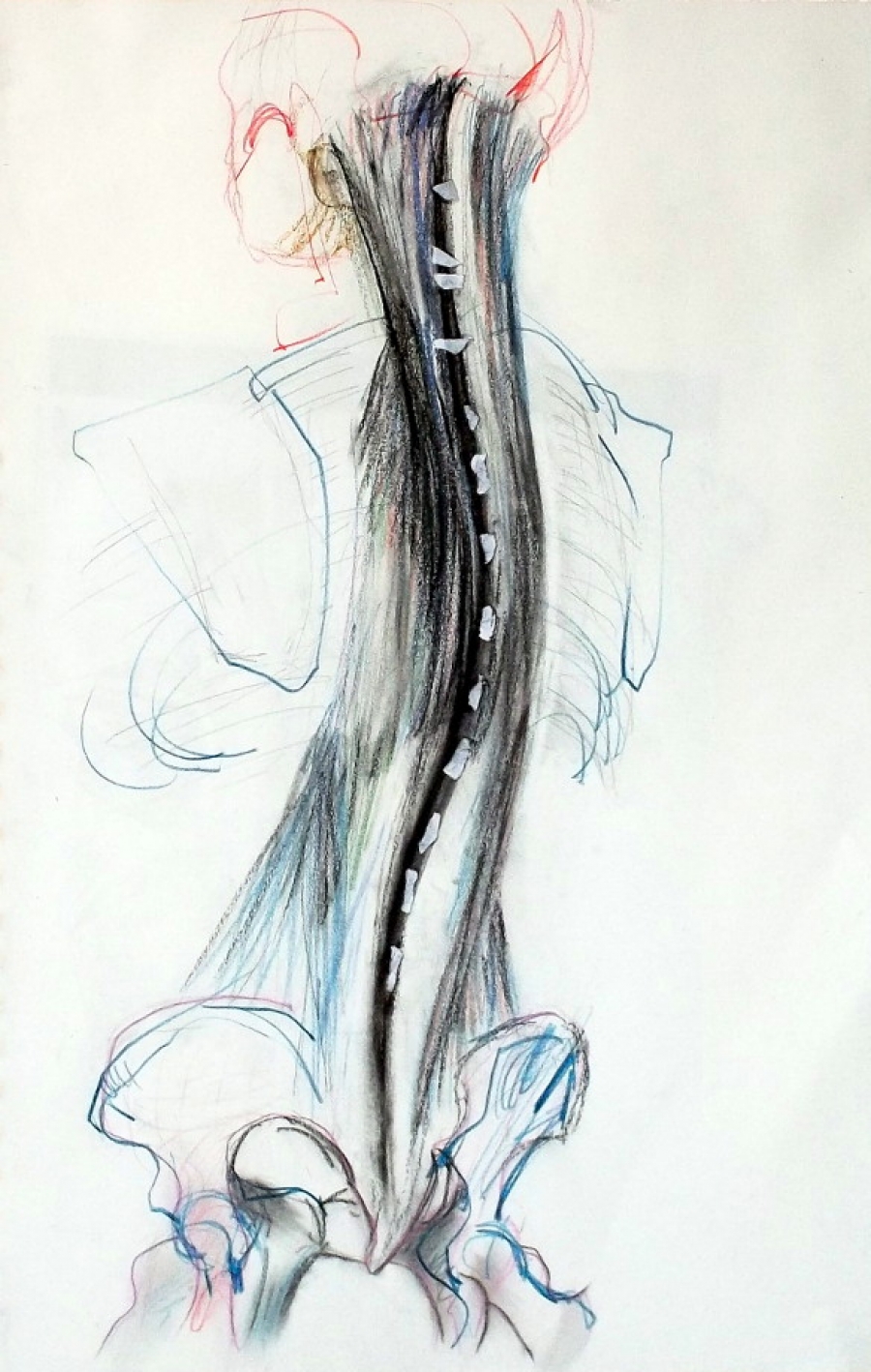
“Anatomy 9,” 28 x 42 cm
Which masters of art are you most inspired by? Are there any modern artists you look up to as well?
As way of proceeding I’m quite independent as I began as self taught, but I read some books along the years that inspired me a lot or that I identified with, especially “Drawing on the Right Side of the Brain” by Betty Edwards, “Concerning the spiritual in art” by Wassily Kandinsky and “Stroke by Stroke” by Henri Michaux. Then last winter I attended the Brera academy in Milan – I knew professors that are great artists also, and I got very inspired by them over all by Barbara Giorgis and Maria Tcholakova, so much that this year I will attend again.
When did you first think of the idea for your Stains series? What do the shapes you paint look like to you?
For the stains I got inspired and started by artist and professor Barbara Giorgis, then of course I developed them in my own way. I just play with colours and shapes and then I let the intuition work for me.
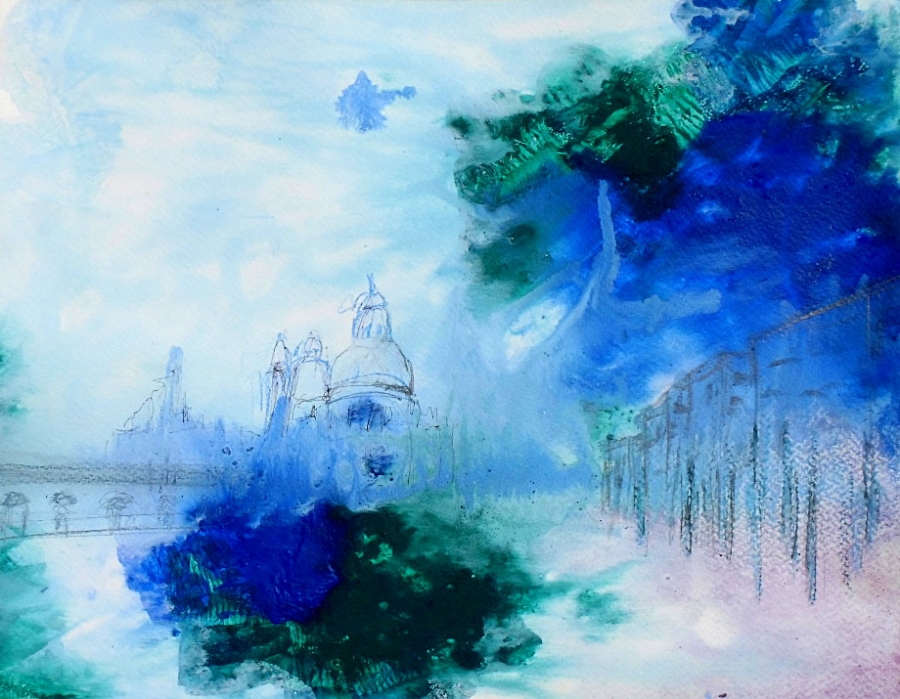
“Venice,” 25 x 35 cm
What’s your earliest memory of creating/painting/drawing?
My great-great father was a painter. He never taught me anything, but when as a child I went to visit, I always found a blank canvas and colors ready to be used in his studio. So without saying anything while the adults chat, I went to his studio and did a painting, it was like a mutually concealed understanding. He appreciated a lot even though he was not a man of many words. Later I stopped painting for many many years, until I started again when I lived in Brazil about at the age of 28, doing lots of collages with founded objects, and later adding on paint.
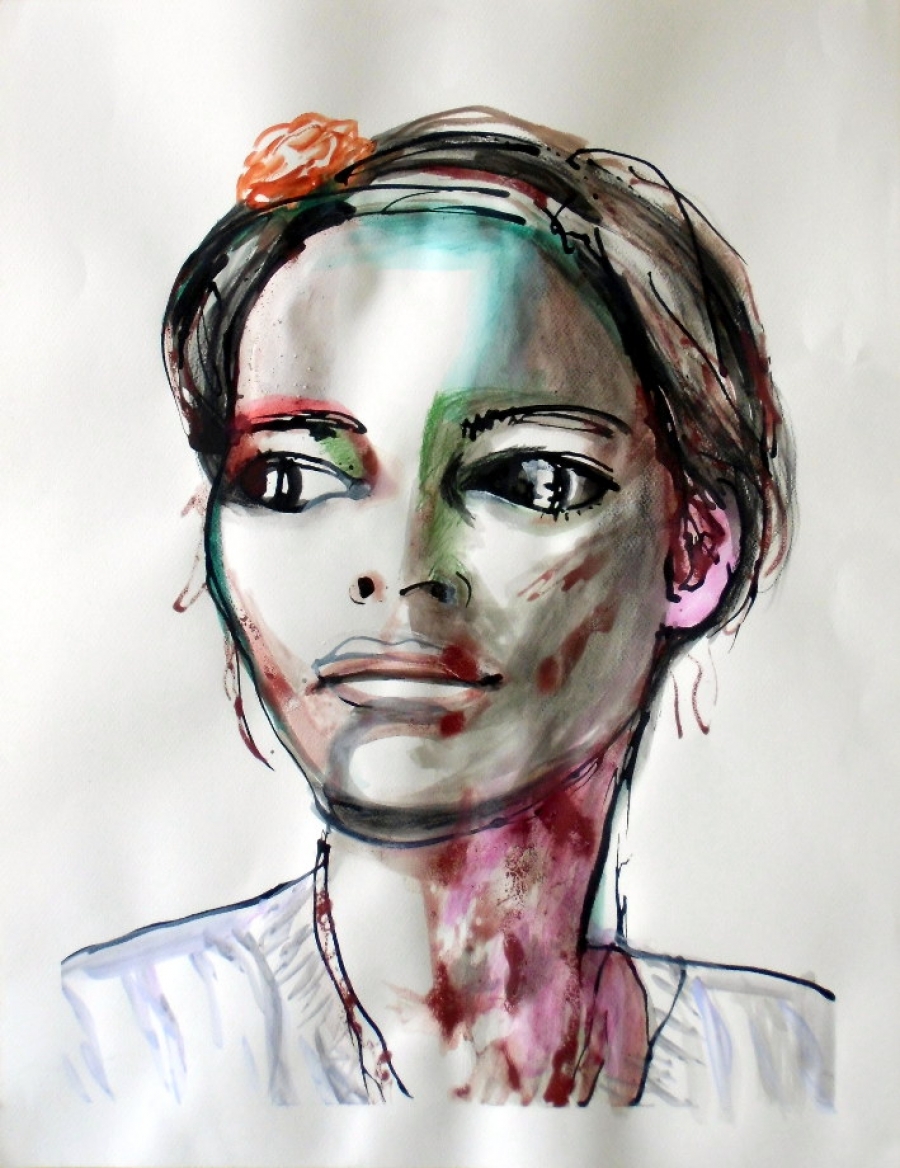
“Self portrait,” 50 x 65 cm
For more of Ilaria’s work, check out her website, and find her on Facebook and Twitter.































